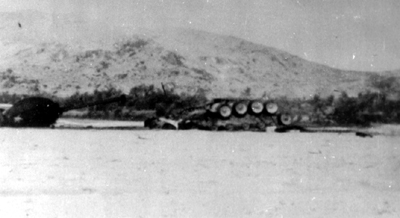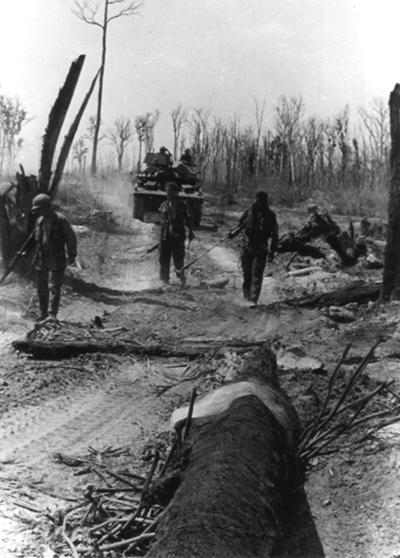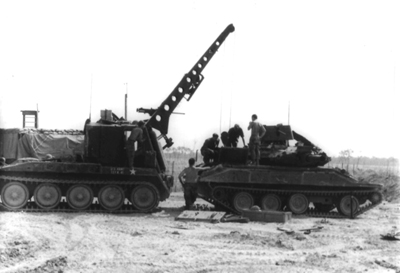Chapter IX:
Reflections
It is always difficult to draw up a list of lessons to be inferred from
the experiences of any war. It is even more difficult, perhaps
presumptive, to extrapolate the lessons of one war, and, invoking some
rule of universality, correctly claim their relevance to another
war-especially to one in the future. It is obvious that we do not readily
learn from our own mistakes, and that we learn even less from the mistakes
of others. For example, the penchant of the French for piecemeal use of
armored units and how that practice worked to their disadvantage in
Vietnam had been recorded. In addition, cautions against peacemeal use of
armored units had been an important part of U.S. military doctrine since
World War II. These words of caution came after a long and bitter struggle
between a handful of American cavalrymen who saw in armored forces
something more than support for dismounted infantry and American
infantrymen who clung tenaciously to the idea that armored forces were
merely support for infantry. But many American combat leaders, both young
and old, never heeded the caution, despite the experiences of armored
units in World War II. We went on to make the same mistakes again in
Vietnam, with air cavalry, ground cavalry, mechanized infantry, tank
battalions, and other units. We simply had not learned our lessons.
In Vietnam the cost to U.S. forces of committing armor piecemeal was not
noticeably high, but on another battlefield, against a more powerful
enemy-one that could capitalize on the mistake by destroying any
fragmented force-the mistake could be fatal. Was it recognition that the
enemy in Vietnam was unlikely to be able to destroy the fragmented forces
that persuaded senior U.S. commanders to split their armored units? Or was
it a serious mistake reflecting the failure of the military to learn from
the past? Armor soldiers would argue for the latter-that it was a mistake,
a typical and frequently repeated mistake in any war generally viewed by
senior commanders as an infantry war. It was made in Korea, it was made in
Vietnam. In the case of Vietnam, advice based on a considerable body . of
experience was available from American officers who had served as advisers
to South Vietnamese armored units early in the war. For a number of
reasons this advice either was not offered to the right people or was not
heeded by
[220]
senior officers able to influence policy and tactics in the employment
of armor. We cannot afford to make this mistake again.
The second lesson of Vietnam has to do with finding the enemy, to which
was closely tied possibly the most exciting development of the Vietnam
era: the fielding of air cavalry. Although the problem exists to some
extent in any war, in Vietnam the need to find the enemy before he could
assemble and organize his forces was critical. Especially important in a
future war will be an early knowledge of where the enemy has massed those
weapons that will be vital to success in the battle. The special mobility
of air cavalry will provide a badly needed means of reconnaissance and
surveillance.
In the later stages of the war in Vietnam, when air cavalry was
confronted with sophisticated enemy air defenses, it became apparent that
the reconnaissance could still be performed if the commander was willing
to pay the price of knocking out enemy air defenses. If information on the
enemy is necessary, then the price must be paid. We must not dispense with
air cavalry on the theory that it can only survive against an enemy
possessing little or no air defense. The scouting
mission-reconnaissance-is still critical. Air cavalry adds a new dimension
to reconnaissance, one complementary to reconnaissance by ground scouts in
armored cavalry units. That armored cavalry units in Vietnam were widely
used as combat maneuver forces should not be allowed to obscure the fact
that they are still a part of the central core of the reconnaissance team.
The air cavalry-ground combination can give a much needed advantage to the
force commander who uses it wisely.
In Vietnam there was considerable use of air cavalry troops and
squadrons as divisional, corps, or field force troops; in some cases
gunships from air cavalry were used for armed escort and scout helicopters
for staff visits. These practices, while a boon to senior headquarters,
did all too little for tactical commanders at brigade level and below.
Only in the 11th Armored Cavalry were air and ground cavalry integrated
into a single operational team under a brigade level commander. Colonel
George S. Patton once said that the operation of the 11th Cavalry when he
was in command really depended on the eyes of those nine warrant officers
riding as scouts in his regimental air cavalry troop. The employment of
integrated air and ground cavalry must be fully developed and expanded if
we are to realize the full potential of the new reconnaissance team.
Third among the lessons taught by Vietnam is what can be done in area
and route security, especially in an area traditionally considered the
rear. In Vietnam of course there was no rear area; the
[221]

M48A3 TANK EXPLODES A 750-POUND BOMB SET UP AS A MINE. Turret
was hurled from tank, which was blown out of its tracks.
enemy was all around. Such a situation could be encountered in a
fast-moving war. Usually the U.S. Army has used armored cavalry and other
armored units for rear area security.
In the II Corps Tactical Zone for most of the war the 1st Battalion,
69th Armor, and 1st Squadron, 10th Cavalry, acted as reaction forces. At
one point in 1970 the 11th Cavalry in the III Corps Zone was daily
clearing mines from and providing security for almost 100 miles of
logistical resupply routes and farm-to-market roads. While for many
reasons armored units are good at this work, the practice can be, and
indeed was in Vietnam, a considerable drain on combat forces capable of
accomplishing much more for their commander than clearing roads and
protecting logistical units.
With limited combat forces at our disposal, it would seem far better to
equip and train logistical units to protect themselves, and to furnish
area security by providing military police or other units mounted in
armored cars and firing weapons designed for the form of enemy resistance
they can expect to encounter. In Vietnam some military police units were
equipped with armored cars for this purpose, but the system was never
widely used. Province chiefs late in the war had their own provincial
reconnaissance units mounted in armored cars, and these essentially
performed rear area and route security operations. From the standpoint of
returns for manpower and equipment invested, it was a far more cost
effective operation than assigning a tank, a mechanized infantry, or an
armored cavalry unit the same task. The concept of furnishing protection
for rear areas and resupply routes in part with the units
[222]
 ENGINEERS CLEAR TRAIL OF MINES IN CAMBODIA
stationed in the area and in part with a military police type of unit
equipped for this purpose needs full exploration and development.
Fourth among the lessons the Vietnam War offers us is the proof that we
still need to find better ways of dealing with land mines. Because of the
nature of the war, the enemy was able to do great damage with random
mines, some of which were relatively simple. Historically, antiarmor land
mines have been a persistent and vexing problem for which no really
satisfactory solution has ever been found. Our failure to solve the
problem of mines laid in patterns has been aggravated by our similar
failure to cope with random mining tactics. We must capitalize, therefore,
on the experience the U.S. Army gained in dealing with enemy random mining
techniques in Vietnam. We must work out a system for using random mines
against armor ourselves. And, finally, since random mining can be used
against us again, we should develop equipment for swift search and
elimination of such land mines. Since World War II almost nothing has been
done in this field. The mine rollers sent to Vietnam were not as effective
as some 1945 equipment.
The body of experience in logistical support for armored units in
Vietnam has useful lessons in maintenance, supply, and battlefield
recovery. Maintenance units tended to operate well to the rear.
Considerable pressure was required in many cases to persuade them
[223]
ENGINEERS CLEAR TRAIL OF MINES IN CAMBODIA
stationed in the area and in part with a military police type of unit
equipped for this purpose needs full exploration and development.
Fourth among the lessons the Vietnam War offers us is the proof that we
still need to find better ways of dealing with land mines. Because of the
nature of the war, the enemy was able to do great damage with random
mines, some of which were relatively simple. Historically, antiarmor land
mines have been a persistent and vexing problem for which no really
satisfactory solution has ever been found. Our failure to solve the
problem of mines laid in patterns has been aggravated by our similar
failure to cope with random mining tactics. We must capitalize, therefore,
on the experience the U.S. Army gained in dealing with enemy random mining
techniques in Vietnam. We must work out a system for using random mines
against armor ourselves. And, finally, since random mining can be used
against us again, we should develop equipment for swift search and
elimination of such land mines. Since World War II almost nothing has been
done in this field. The mine rollers sent to Vietnam were not as effective
as some 1945 equipment.
The body of experience in logistical support for armored units in
Vietnam has useful lessons in maintenance, supply, and battlefield
recovery. Maintenance units tended to operate well to the rear.
Considerable pressure was required in many cases to persuade them
[223]
that they could and should operate teams as far forward as squadron and
battalion, making repairs on the site at company, troop, and battery
level. The alternative was a long haul of damaged equipment back to a
maintenance camp and a long haul of repaired equipment back to the unit-a
very expensive procedure. At one point, the 11th Armored Cavalry was
hauling its damaged Sheridans nearly 150 kilometers round trip. The fact
that such a situation existed calls for some reexamination of traditional
direct and general support relationships. Some way must be found to
provide better security for rear area support units and the routes to and
from their customers. Otherwise the customer pays the price to secure the
rear and the routes. This cannot go on. Perhaps we have too many
intermediate levels of maintenance to operate effectively any longer.
Whether or not this is true, we need to find out.
U.S. Army logistical policy calls for area support by maintenance and
supply units. In short, support units provided maintenance and supply so
long as the using unit was in the geographic area the supporting unit was
assigned to support. When the unit moved to another area, its support then
came from a unit charged with support in the new area. The problem is that
the parts supply system functions on equipment densities and spare parts
usage rates. There is not now, and never has been, any satisfactory way to
transfer along with the customer unit its experience factors and supply
stocks, built up in the supporting unit on the basis of the customer usage
factors. The result-in the eyes of the using unit-was that support broke
down completely when the unit moved to a new area. At best the spare parts
supply system was capable of filling no more than 50 to 60 percent of unit
demands; the remaining 40 to 50 percent were filled by cannibalization of
machines no longer useful in combat and by going outside the normal supply
system-in other words by scrounging parts. On a battlefield in mobile
warfare, even this system breaks down. Armored units must have immediately
available direct support maintenance and supply as well as adequate
backup. In any event, the maintenance and supply methods are in need of
close scrutiny and change.
The supply vehicle fleet provided for American armored units in Vietnam
was generally unsuited to its tasks. In a country with few and poor
secondary roads, it was necessary to replace wheeled cargo carriers with
full-tracked cargo vehicles-M548's. These vehicles were essential to the
operations of armored units in wide areas along the borders; the Cambodian
expedition, for example, could not have been undertaken without them. They
were not, however, provided in sufficient numbers in Vietnam and their
maintenance reliability was suspect.
[224]
 M578 LIGHT RECOVERY VEHICLE WORKS ON SHERIDAN
Armored units have always been plagued with the problems of whether
their supply fleet should be capable of operating on roads or
cross-country, or bath. In an attempt to design vehicles that would do
both, neither capability was provided satisfactorily. In forward areas,
especially in countries with limited road nets, tracked resupply vehicles
at unit level are essential. On the other hand, somewhere there must be a
vehicle fleet which can move large volumes of supplies quickly over
roads-even if those roads are secondary by some standards. This is
primarily an organizational and equipment problem. However, the M548 was
the last of its kind; therefore the U.S. Army needs to look seriously at
the tracked cross-country resupply capability in forward areas, as well as
the long-haul fleet that ]packs it up.
Recovery of damaged or inoperative vehicles has always been a difficult
problem for armored units, and so it was in Vietnam. In respect to both
number and reliability of vehicles used, the recovery system was inadequate. The M578 and the M88-the bulk of the recovery fleet-were in
short supply for cavalry units, and the M578 was not well designed for its
job. The 11th Armored Cavalry attacked into Cambodia with its organic
recovery fleet bolstered by almost a dozen M88's borrowed for the occasion
out of depot stocks. For almost two weeks, regimental maintenance
operations lived on the guts and staying power of these vehicles and their
crews.
[225]
M578 LIGHT RECOVERY VEHICLE WORKS ON SHERIDAN
Armored units have always been plagued with the problems of whether
their supply fleet should be capable of operating on roads or
cross-country, or bath. In an attempt to design vehicles that would do
both, neither capability was provided satisfactorily. In forward areas,
especially in countries with limited road nets, tracked resupply vehicles
at unit level are essential. On the other hand, somewhere there must be a
vehicle fleet which can move large volumes of supplies quickly over
roads-even if those roads are secondary by some standards. This is
primarily an organizational and equipment problem. However, the M548 was
the last of its kind; therefore the U.S. Army needs to look seriously at
the tracked cross-country resupply capability in forward areas, as well as
the long-haul fleet that ]packs it up.
Recovery of damaged or inoperative vehicles has always been a difficult
problem for armored units, and so it was in Vietnam. In respect to both
number and reliability of vehicles used, the recovery system was inadequate. The M578 and the M88-the bulk of the recovery fleet-were in
short supply for cavalry units, and the M578 was not well designed for its
job. The 11th Armored Cavalry attacked into Cambodia with its organic
recovery fleet bolstered by almost a dozen M88's borrowed for the occasion
out of depot stocks. For almost two weeks, regimental maintenance
operations lived on the guts and staying power of these vehicles and their
crews.
[225]
Recovery of damaged armored vehicles is both an organizational and a
doctrinal problem. Normally unit recovery equipment evacuated vehicles to
a collecting point where the vehicles were picked up by support units that
moved along behind the forward elements. With support units immobilized
far to the rear, the burden of battlefield recovery fell to the fighting
units-a situation quite likely to recur on a battlefield in the future.
There is, therefore, a need for better recovery equipment and more of it
at unit level, and a close look at how the
Army intends to recover and
evacuate disabled vehicles in future wars.
Much useful experience was gained in the Vietnam War. We have seen that
the combined arms team is essential and that fighting with troops mounted
is advantageous. It is also plain that the American advisers to the South
Vietnamese Army were important but that their preparation for the tasks
that confronted them was poor. All these experiences and many more must be
carefully analyzed.
As we look to the future it is essential not only that we know the
lessons of Vietnam, but that we understand them as well. Understanding
them, in their correct context, and relating that to the future will take
more time and space than we have had available for this monograph. But it
must be done. We can no more turn our backs on our experiences in Vietnam
than we can take those experiences, relate them directly to our next
battlefield, and so in the end get ready to fight better the war we have
just left behind. The wisdom to learn from experience, without merely
getting better prepared to relive that experience, is not easily won. But
win it we must. We owe it to ourselves and our country. More however, we
owe it to the brave men who went, helped us learn the lessons, and paid
the price of learning. They left us a large legacy larger perhaps than we
deserve.
[226]
Previous Chapter
page created 17 January 2002
Return to the
Table of Contents
-



